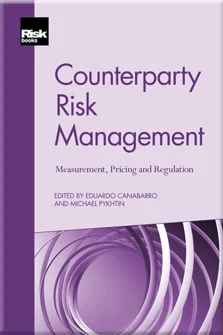Adjoint Algorithmic Differentiation: Real-Time Counterparty Credit Risk Management in Monte Carlo Simulations
Luca Capriotti and Jacky Lee
The Basel III Enhancements to Counterparty Risk Capital Charges
The Regulation of Counterparty Risk in Over-the-Counter Derivatives Markets
The Non-Internal Model Method for Counterparty Credit Risk
On Credit Valuation Adjustments and Regulatory Capital
American Monte Carlo: A Practitioner Approach
Best Market Practice for Calculation and Reporting of Wrong-Way Risk
Central Counterparty Risk
CVA Risk Management Post-Crisis
Re-Thinking CVA: Valuations, Counterparty Credit Risk and Model Risk
Should Derivatives Dealers Make A Funding Value Adjustment?
Adjoint Algorithmic Differentiation: Real-Time Counterparty Credit Risk Management in Monte Carlo Simulations
Stress Test of Counterparty Risks and Dynamic Hedging of the CVA
Dynamic Stress Testing of Counterparty Default Risk
Collateral: Modelling, Pricing and Optimisation

One the most active areas of risk management today is counterparty credit risk management (CCRM). Managing counterparty risk is particularly challenging because it requires the simultaneous evaluation of all the trades facing a given counterparty. For multi-asset portfolios this typically comes with extraordinary computational challenges.
Indeed, with the exclusion of the simplest portfolios of vanilla instruments, computationally intensive Monte Carlo simulations are often the only practical tool available for this task. Standard approaches for the calculation of risk require repeating the calculation of the profit and loss (P&L) of the portfolio under hundreds of market scenarios. As a result, in many cases these calculations cannot be completed in a practical amount of time, even employing a vast amount of computer power. Since the total cost of the through-the-life risk management can determine whether it is profitable to execute a new trade, solving this technology problem is critical in order to allow a securities firm to remain competitive.
Following the introduction of adjoint methods in finance (Giles and Glasserman 2006), a computational technique dubbed “adjoint
Copyright Infopro Digital Limited. All rights reserved.
As outlined in our terms and conditions, https://www.infopro-digital.com/terms-and-conditions/subscriptions/ (point 2.4), printing is limited to a single copy.
If you would like to purchase additional rights please email info@risk.net
Copyright Infopro Digital Limited. All rights reserved.
You may share this content using our article tools. As outlined in our terms and conditions, https://www.infopro-digital.com/terms-and-conditions/subscriptions/ (clause 2.4), an Authorised User may only make one copy of the materials for their own personal use. You must also comply with the restrictions in clause 2.5.
If you would like to purchase additional rights please email info@risk.net







